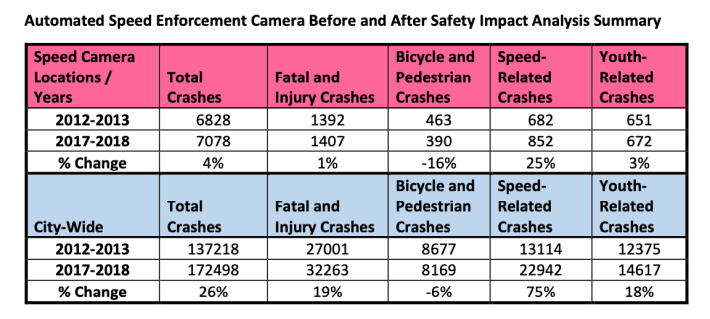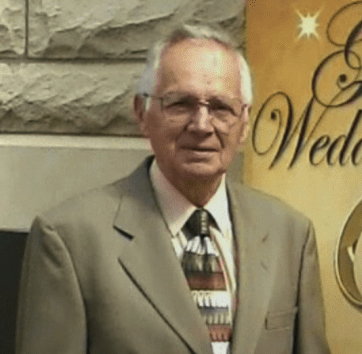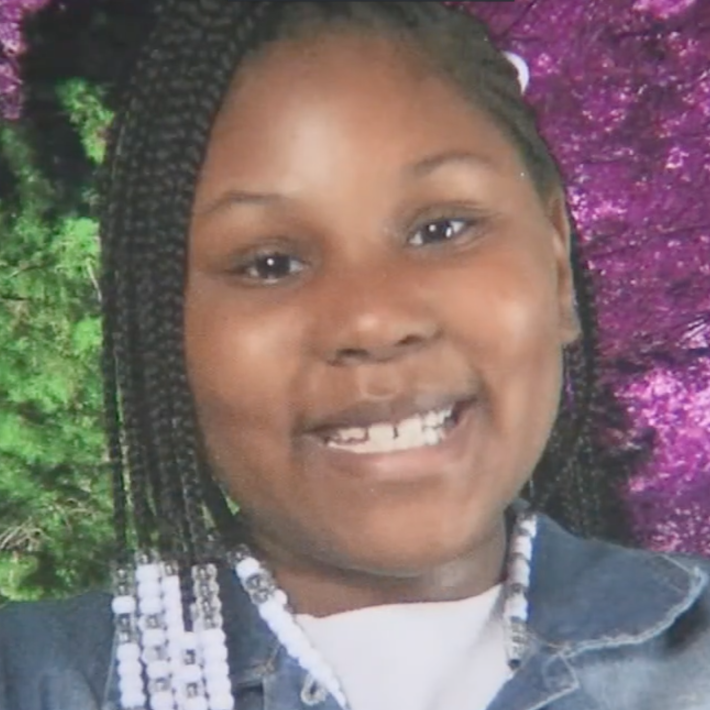Streetsblog Chicago didn’t endorse Mayor Lori Lightfoot's new policy of lowering the speed camera ticketing threshold to 6 mph, due to the current financial hardships many residents are facing during the pandemic. However since the new rule is now in effect, we're hoping there won't be undue impacts on lower-income and working-class Chicagoans, and optimistic that we'll see added safety benefits from the stricter enforcement.
Unsurprisingly, the 6 mph regulation has triggered a new backlash from right-leaning outlets like the Chicago Tribune and the Illinois Policy website, which have implied that our city's traffic camera program is simply a money grab with few safety benefits. But the fact remains that speed cameras are effective for preventing injuries and deaths, and fresh data from the Chicago Department of Transportation released this week reaffirmed that.
While fatal or serious injury crashes spiked by 19 percent increase citywide between 2012-13 and 2017-18, likely because of an increase in driving due to the rise of ride-hail use, that increase was only 1 percent near speed cameras. And while speed-related crashes went up by 75 percent across the city during that period, the increase at cam locations was only 25 percent.

But it's not just city officials who are promoting the benefits of traffic cameras. Recently the Archer Heights Civic Association, representing the blue-collar Southwest Side community, put out an open letter stating that the group "supports automated traffic law enforcement -- and wants more of it."
"Driving is a way of life in many Chicago neighborhoods, as well as Archer Heights," wrote civic association president Thomas S. Baliga. "Recently abuse of the driving privilege – speeding – has, very unfortunately, been a too frequent cause of death on our community."
Baliga noted that Cecilia Bautista, 16, was killed last October when the driver of the car she was riding in sped through a red light in Archer Heights and struck another vehicle. He added that last July another driver doing 76 mph killed Patricia A. Wickers, 77, on Archer Avenue near Midway Airport.
Baliga also noted that Juan Valadez-Espinoza, 39, died last April after speeding down Archer in Archer Heights, striking another vehicle, and careening into a telephone pole. And he pointed out that, also in April, another driver a driver struck and killed 83-year-old Jan Kopec as he rode his bike on Archer in the neighborhood.
"In our community of Archer Heights, we have lived with the grief and the fear caused by these horrible tragedies, and we have been debating how to make our streets safer," Baliga wrote. He said the group reached a consensus that speed and red light cameras promote safety, and there should be more of them in the neighborhood, and they endorse the new 6 mph rule, which he said "will save lives and make streets safer to cross, walk, shop, and live along."
Baliga noted that Archer Heights has two major corridors that are plagued by speeding. These are Archer from 47th Street southwest to Cicero Avenue, and Cicero from the Stevenson Expressway to Midway Airport. Cicero, a six-lane road, is particularly dangerous, he said. "Drivers treat the road as if it were an airport access highway, driving 45-50 miles an hour, and higher, in a 30 mph zone.
He pointed out that already this year Archer Heights has seen a deadly crash. On January 21, 12-year-old Cire Robinson was killed and four people were injured during a head-on collision near 49th Street and Cicero. "This was a terrible loss that we wish could have been prevented."
Baliga noted that even aside from deadly traffic violence, speeding on these wide streets is a barrier to mobility for families and seniors doing essential errands. "I personally have witnessed young mothers – baby in hand, child in tow, pushing an occupied baby carriage – courageously racing through the Cicero/Archer intersection. I cringe each time I see a senior, or a person using a cane, try to traverse these intersections."
Baligia pointed out that speeding is a citywide problem because "violators are confident they can speed and drive recklessly, knowing they will likely never receive a ticket." He argued that the 6 mph threshold, and the ensuing $35 tickets, will encourage people to slow down. He added that CDOT notes that recorded speeds of drivers have been consistently been going down in speed camera zones since cameras were first installed in the early 2010s. Moreover, about 90 percent of motorists who got a speed cam ticket in 2019 didn't get caught making a second violation that year. "So the message is getting through."
He argued that during a time when many of us are impacted by the stresses of COVID-19, traffic violence is a public health issue that we can take concrete steps to address. "Looking the other way on speeding, or claiming that enforcing the speed limit is a cash grab, sends the message that deadly speeding is no big deal – and that our neighborhoods can be ignored."
"No one likes getting a speeding or red light ticket," Baliga concluded. "But there is one simple way to avoid getting a single ticket in the first place: Just drive the speed limit, respect red lights, and come to a complete stop at all stop signs, especially by our schools. You'll save yourself a ticket, and you may save a life."
When so much of the commentary on automated enforcement takes a windshield point of view that traffic cameras are an imposition on the freedom of drivers, it's refreshing to read such a commonsense, and heartfelt, argument for why the cams are needed.







